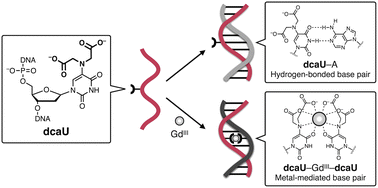Metal-dependent base pairing of bifacial iminodiacetic acid-modified uracil bases for switching DNA hybridization partner†
Abstract
Dynamic control of DNA assembly by external stimuli has received increasing attention in recent years. Dynamic ligand exchange in metal complexes can be a central element in the structural and functional transformation of DNA assemblies. In this study, N,N-dicarboxymethyl-5-aminouracil (dcaU) nucleoside with an iminodiacetic acid (IDA) ligand at the 5-position of the uracil base has been developed as a bifacial nucleoside that can form both hydrogen-bonded and metal-mediated base pairs. Metal complexation study of dcaU nucleosides revealed their ability to form a 2:1 complex with a GdIII ion at the monomeric level. The characteristics of base pairing of dcaU nucleosides were then examined inside DNA duplexes. The results revealed that the formation of the metal-mediated dcaU–GdIII–dcaU pair significantly stabilized the DNA duplex containing one dcaU–dcaU mismatch (ΔTm = +16.1 °C). In contrast, a duplex containing a hydrogen-bonded dcaU–A pair was destabilized in the presence of GdIII (ΔTm = −3.5 °C). The GdIII-dependent base pairing of dcaU bases was applied to control the hybridization preference of DNA in response to metal ions. The hybridization partner of a dcaU-containing strand was reversibly exchanged by the addition and removal of GdIII ions. Since the incorporation of a single dcaU base can switch the hybridization behavior of DNA, the bifacial dcaU base would be a versatile building block for imparting metal responsiveness to DNA assemblies, allowing the rational design of dynamic DNA systems.

- This article is part of the themed collection: 2023 Chemical Science Covers


 Please wait while we load your content...
Please wait while we load your content...